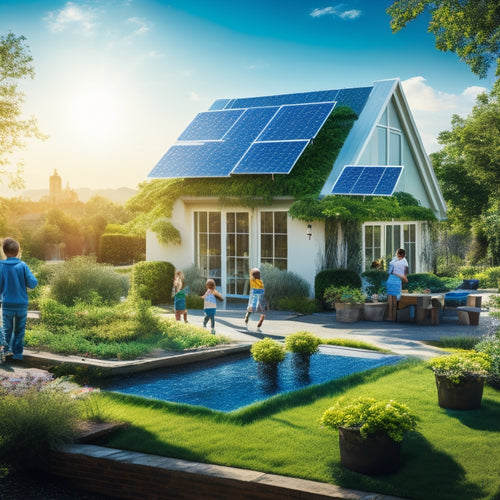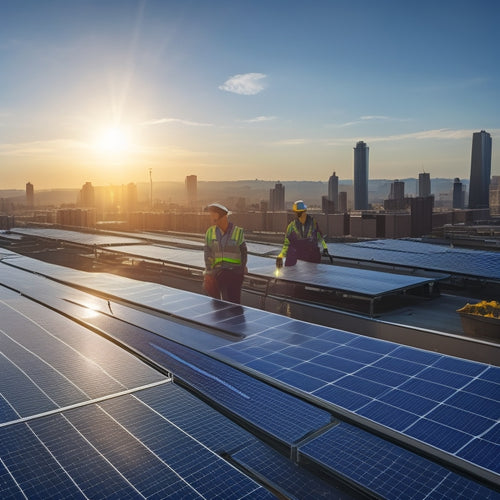
What Number of Solar Panels Are Needed to Power a House?
Share
To determine the number of solar panels needed to power your house, you'll need to calculate your daily energy usage in watt-hours, assess your roof's size and space, and factor in your location's climate and sun exposure, as well as the efficiency and type of solar panels you choose. You'll also need to take into account your energy usage patterns, peak sun hours, and potential shading from trees or buildings. By evaluating these factors, you'll be able to determine the ideal number of solar panels required to meet your energy needs. Now, let's break down each of these factors to get a more accurate calculation.
Key Takeaways
- Determine your daily energy usage in watt-hours (Wh) to calculate the required solar panel capacity.
- Assess your roof size, orientation, and shading to determine the suitable number of solar panels.
- Consider your location's peak sun hours and seasonal variations to optimize energy production.
- Choose the right panel size and type based on your energy needs, roof space, and budget constraints.
- Calculate the total system size required by considering your monthly energy usage and local building codes.
Determining Your Energy Needs
To accurately determine the number of solar panels needed to power your house, you must first pinpoint your energy needs. This involves evaluating your energy consumption habits, which can vary considerably depending on factors such as the size of your household, appliances, and lighting.
You'll need to calculate your total daily energy usage in watt-hours (Wh). Consider seasonal variations, as your energy needs may fluctuate throughout the year. For instance, you may use more energy during winter for heating or summer for cooling.
You can use your past utility bills to get an idea of your energy consumption patterns. Analyze your bills to identify the highest and lowest usage periods, and calculate your average daily energy usage.
Next, you'll need to determine your peak sun hours, which is the amount of solar energy your location receives per day. This will help you determine the required solar panel capacity to meet your energy needs.
Understanding Solar Panel Efficiency
You need to contemplate the panel's energy conversion rate, which is the percentage of sunlight converted into electrical energy.
This rate is influenced by cell efficiency factors, including the type and quality of photovoltaic cells used in the panel.
Panel Energy Conversion Rate
The photovoltaic (PV) cells within solar panels convert sunlight into electrical energy with varying degrees of efficiency. As someone looking to power your house with solar energy, understanding the panel energy conversion rate is vital. This rate, also known as the conversion efficiency, affects the overall panel performance and energy yield.
You should know that the conversion rate is the percentage of sunlight that's successfully converted into electrical energy. For instance, if a solar panel has a 20% conversion rate, it means that 20% of the sun's energy hitting the panel is converted into usable electricity. The remaining 80% is lost as heat.
When evaluating solar panels, look for those with high conversion rates, as they'll generate more power per hour of sunlight. This is particularly important if you have limited roof space, as high-efficiency panels can maximize your energy yield.
While higher conversion rates often come at a higher cost, they can lead to greater savings in the long run.
Cell Efficiency Factors
Several factors influence a solar panel's cell efficiency, including its semiconductor material, temperature, and design structure.
You'll find that solar cell materials like monocrystalline silicon, polycrystalline silicon, and thin-film materials each have their own efficiency ratings. Monocrystalline silicon, for instance, boasts higher efficiency rates due to its higher purity levels.
Temperature also plays a significant role in cell efficiency. Higher temperatures can decrease efficiency, while lower temperatures can increase it. That's why it's important to verify your solar panels are installed in a way that allows for adequate airflow and cooling.
Design structure is another critical factor, as it affects how well the solar cells are arranged to maximize energy absorption.
Efficiency improvements can be achieved through advancements in design, such as bifacial solar cells that can absorb energy from both the front and back sides of the panel.
Calculating Roof Size and Space
You'll need to assess your roof's space to determine how many solar panels can fit.
To do this, you'll calculate the available roof area, factoring in obstacles like vents, skylights, and chimneys.
Roof Space Assessment
Your roof's surface area is a critical factor in determining how many solar panels you can fit, and subsequently, how much energy you can generate.
When evaluating your roof space, you need to take into account several factors that affect the installation and performance of your solar panel system.
You'll want to review the following key aspects of your roof:
-
Roof orientation: A south-facing roof is ideal, as it receives the most direct sunlight throughout the day. East- and west-facing roofs can also work well, but north-facing roofs are less suitable.
-
Roof material: Verify your roof is made of a durable, compatible material, such as asphalt shingles, metal, or concrete tiles. Some materials, like slate or clay tiles, may be more challenging to work with.
-
Obstructions: Identify any obstructions, such as skylights, vents, or chimneys, that could interfere with the installation or reduce the system's energy output.
- Shading: Evaluate the amount of shading your roof receives from nearby trees, buildings, or other structures, as excessive shading can greatly impact your system's performance.
Available Roof Area
Having assessed your roof's orientation, material, obstructions, and shading, you can now determine the available roof area for your solar panel installation. To calculate the available roof area, you need to measure the length and width of your roof in feet. Measure the length and width of each section of the roof, considering any obstructions such as vents, skylights, and chimneys.
| Roof Section | Dimensions (ft) |
|---|---|
| Section 1 | 20 x 30 |
| Section 2 | 15 x 25 |
| Section 3 | 10 x 20 |
| Total |
Multiply the length and width of each section to get the square footage. Add up the square footage of each section to get the total available roof area. Make sure you subtract any areas with obstructions or shading.
For the best solar panel installation, consider the roof orientation and material. A south-facing roof with a pitch between 30-40 degrees is ideal. Avoid installing solar panels on roofs with asphalt shingles, as they can be damaged during installation. Instead, opt for metal or concrete roofs, which can support the weight of solar panels.
Factoring in Climate and Location
The region's climate and location play a significant role in determining the number of solar panels needed to power a house, as they directly impact the amount of sunlight available to generate electricity.
You'll need to take into account factors like the amount of cloud cover, temperature, and sunlight hours per day in your area.
Here are 4 key location-based factors to take into account:
-
Latitude: If you live closer to the equator, you'll receive more direct sunlight, reducing the number of panels needed.
-
Altitude: Higher elevations typically receive more intense sunlight, increasing energy production.
-
Shading: Trees, buildings, or other structures that cast shade on your roof will reduce the amount of sunlight available.
- Seasonal variations: If you live in an area with distinct seasons, you'll need to account for reduced sunlight during winter months.
Taking these factors into account, you may be eligible for solar incentives, which can help offset the cost of your solar panel system and accelerate your path to energy independence.
Choosing the Right Panel Size
Now that you've considered the impact of climate and location on your solar panel system, it's time to focus on selecting the right panel size to meet your energy needs.
The ideal panel size depends on your energy requirements, available roof space, and budget. You'll need to balance panel efficiency, cost, and installation costs.
Standard residential solar panels range from 250 to 400 watts, with higher-efficiency panels generating more power per unit area. However, they come at a higher cost. For example, a 300-watt panel might be more expensive than a 250-watt one, but it'll take up less space on your roof.
Consider high-efficiency panels if you have limited roof space or want to maximize energy production. On the other hand, if budget is a concern, lower-efficiency panels might be a more affordable option.
When choosing panel types, consider factors like durability, temperature coefficient, and warranty.
Be sure to evaluate the installation costs, including labor, mounting hardware, and inverters. By carefully selecting the right panel size and type, you can optimize your solar panel system's performance and maximize your return on investment.
Considering Energy Storage Options
You'll need to evaluate energy storage options to guarantee a steady power supply when the sun isn't shining or during grid outages. This is particularly important if you want to make sure your home remains powered during the night or on cloudy days.
With energy storage, you can store excess energy generated by your solar panels during the day and use it when needed.
When selecting energy storage options, consider the following factors:
-
Battery types: Lead-acid, lithium-ion, and flow batteries are popular options, each with their pros and cons. Lithium-ion batteries, for instance, offer high energy density and long lifetimes.
-
Storage capacity: Calculate your energy storage needs based on your daily energy consumption and the number of days you want to be able to power your home during an outage. A higher storage capacity provides more backup power during extended outages.
-
Depth of discharge (DOD): This refers to the percentage of the battery's capacity that can be safely used without damaging the battery. A higher DOD means more usable energy storage.
- Round-trip efficiency: This measures the efficiency of the energy storage system, with higher efficiencies indicating less energy wasted during charging and discharging.
Assessing Shading and Obstacles
Having guaranteed a reliable energy storage system, it's time to assess the solar panel installation site for potential shading and obstacles.
You'll need to identify any objects that could cast a shadow on your solar panels, such as trees, buildings, or chimneys, and determine their impact on energy production. A shading analysis will help you pinpoint the best solar panel orientation to maximize energy output.
Conduct a thorough site assessment to identify potential obstacles, including roof vents, skylights, and design features that could hinder solar panel installation.
Take note of the roof's pitch, orientation, and condition to ascertain it can support the weight of the solar panels.
You should also consider local building codes and regulations that may affect your solar panel installation.
Sizing Your Solar Panel System
With your site assessment complete, it's time to determine the ideal size of your solar panel system. This involves calculating your energy needs and selecting the right solar panel types to meet those needs.
You'll want to evaluate factors like your energy usage patterns, the amount of sunlight your location receives, and the installation costs.
To get started, assess the following key factors:
-
Your energy usage: How much energy do you use per month? This will help you determine the size of the system you need.
-
Your roof size: How much space do you have available for solar panels? This will impact the number of panels you can install.
-
Local building codes: Are there any regulations that may affect the size or type of system you can install?
- Your budget: What're you willing to spend on your solar panel system?
Frequently Asked Questions
Can I Install Solar Panels on a Rented Property?
You can install solar panels on a rented property, but it's essential to understand your tenant rights and negotiate a solar lease with your landlord, ensuring a mutually beneficial agreement that meets your energy needs.
Are Solar Panels Suitable for Homes With Metal Roofs?
As you envision utilizing the sun's energy on your metal roof, you'll find it's an ideal match; metal roof advantages include its durability and ease of installation, but consider the specific installation considerations, such as securing panels to the metal substrate, to guarantee a seamless and efficient setup.
Can I Use Solar Panels to Power My Electric Vehicle?
You can utilize solar power to fuel your electric vehicle, enjoying EV benefits like reduced emissions and lower operating costs, by installing a solar charging system that meets your vehicle's specific energy requirements.
Do Solar Panels Work During a Power Outage?
You're wondering if solar panels work during a power outage - the answer is, they don't, unless you have a solar battery backup, which provides grid independence, allowing you to utilize stored energy when the grid goes down.
Can I Add More Panels to My Existing Solar System?
You can expand your existing solar setup by adding more panels, but you'll need to verify system compatibility, checking your inverter's capacity and evaluating your roof's structural integrity to support solar panel expansion.
Conclusion
You've crunched the numbers, considered the variables, and sized up your solar panel system. Now, imagine harvesting enough energy to power a small town - okay, maybe not that much, but you get the idea! With the right calculation and setup, you'll be generating electricity like a pro. So, go ahead, flip the switch, and bask in the glow of your newfound energy independence.
Related Posts
-

Solar Energy Benefits for Sustainable Living
Solar energy provides numerous benefits for sustainable living that you can't overlook. By switching to solar, you'll...
-

Solar Installation Guide for Commercial Properties
Implementing solar energy solutions in your commercial property can lead to significant long-term savings and sustain...
-

Integrating Smart Technology for Energy Savings
Integrating smart technology into your home is a transformative factor for energy savings. Smart thermostats give you...


